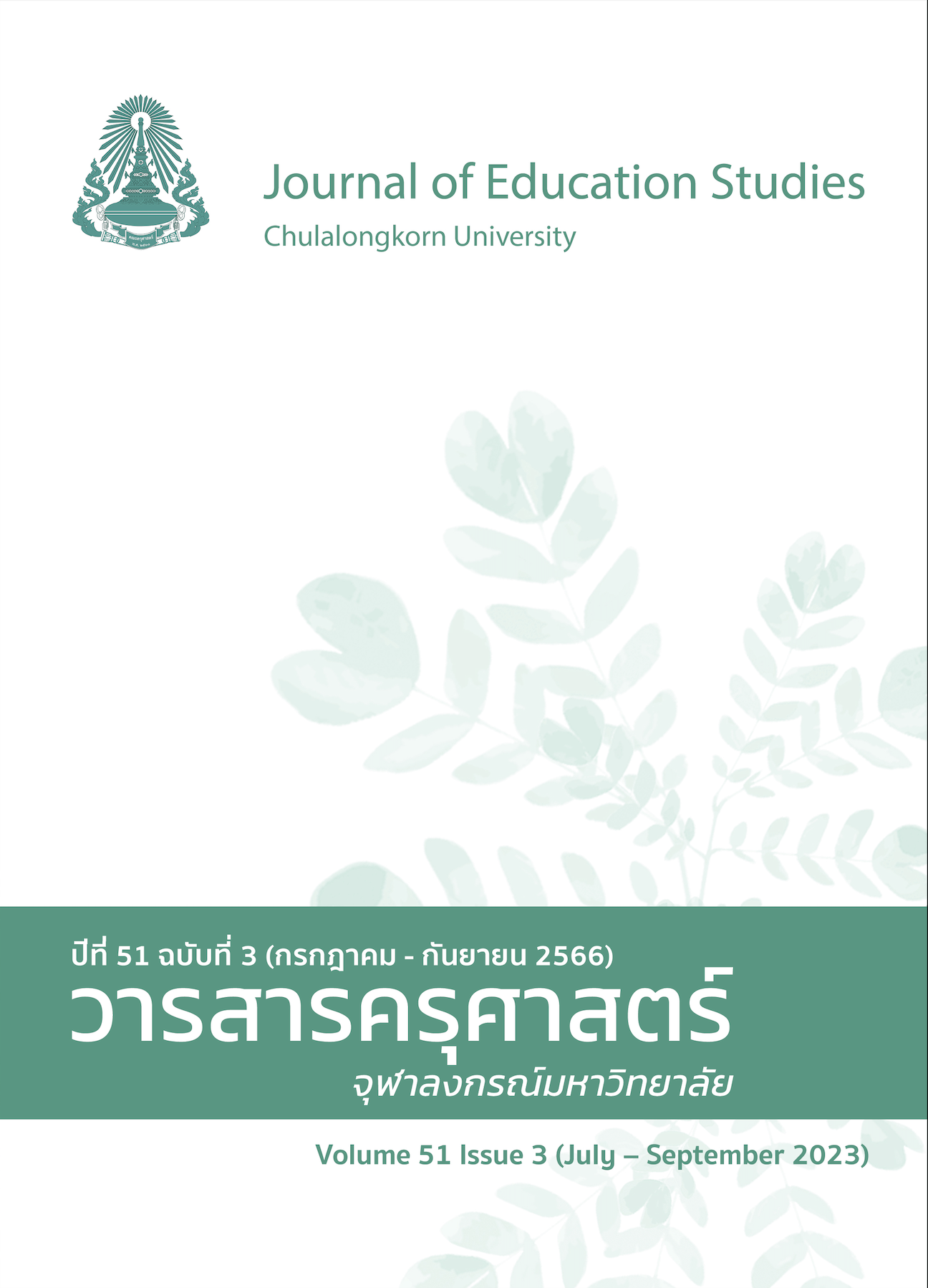The Enhancement of Learning Inspiration by Strategic Life Planning Using AFTER model Assembly with Goodness Based Learning for the Lower Secondary Students in Buriram’s Private School
DOI:
https://doi.org/10.14456/educu.2023.23Keywords:
Keywords: AFTER Model, Goodness Based Learning (GBL), Strategic Life Planning, Learning InspirationAbstract
This pre-experimental research aimed to compare the students’ learning Inspiration before, and after using AFTER model assembly with Goodness Based Learning (GBL) on the Strategic Life Planning lesson plans to enhance student’s learning inspiration, A one-group pretest-posttest design was conducted on 40 lower secondary students using a lesson plan with IOC = 0.80-1.00, high-level quality was implemented 1 period a week for 15 weeks. The Learning Inspiration Scales with IOC = 0.90-1.00 and Cronbach's Alpha Coefficient = .86 were utilized as instruments for data collection. Percentage, mean, standard deviation, and t-test were used for data analysis. The findings were as follows:
- The AFTER Model & GBL on Strategic Life Planning lesson plans to enhance learning Inspiration for lower secondary students consisted of five main components: 1) attention, 2) forethought, 3) tactical planning, 4) execution, 5) reflection, which were integrated with the following practices of the Noble Eightfold Path: 1) right view, 2) right intention, 3) right speech, 4) right action, 5) right livelihood, 6) right effort, 7) right mindfulness, 8) right concentration as the base five steps of the AFTER Model.
- The AFTER Model & GBL on Strategic Life Planning lesson plans affected the students’ learning inspiration through four components: 1) individual drive force, 2) environmental drive force, 3) creative thinking, 4) positive effect; it was found that the mean post-test scores for students’ inspiration increased after using the lesson plans, were higher than the mean pre-test scores at the .05 level of significance.
References
คณะกรรมการการอุดมศึกษา, สำนักงาน. (2562). การสร้างแรงบันดาลใจในการเรียนรู้ของผู้เรียนเพื่อสังคมที่หลากหลาย : Inspiring Student Learning for Diverse Societies. ประมวลบทความในการประชุมวิชาการ (Proceedings) ครั้งที่ 14 ประจําปี 2562. กรุงเทพฯ: สำนักงานคณะกรรมการการอุดมศึกษา และสมาคมเครือข่ายการพัฒนาวิชาชีพอาจารย์และองค์กรระดับอุดมศึกษาแห่งประเทศไทย.
เฉลิมชัย บุญยะลีพรรณ. (2555, 5 มิถุนายน). การปฐมนิเทศต้อนรับนิสิตใหม่. ค่ายเสริมสร้างอัตลักษณ์ มศว. ใน SWU Weekly. Online.
ณัชนรี นุชนิยม. (2562). การสร้างแรงบันดาลใจในการเรียนรู้ด้วยกรอบความคิดเชิงบูรณาการของนักศึกษา. ใน วิรัช เลิศไพฑูรย์พันธ (บ.ก.), การสร้างแรงบันดาลใจในการเรียนรู้ของผู้เรียนเพื่อสังคมที่หลากหลาย. การประชุมวิชาการ (Proceedings) ครั้งที่ 14 ประจําปี 2562 (น. 57-67). สำนักงานคณะกรรมการการอุดมศึกษา และสมาคมเครือข่ายการพัฒนาวิชาชีพอาจารย์และองค์กรระดับอุดมศึกษาแห่งประเทศไทย.
ณัฐสุภา เจริญยิ่งวัฒนา. (ม.ป.ป.). การค้นหาและถ่ายทอดแรงบันดาลใจในงานออกแบบแฟชั่น. วารสารสถาบันนวัตกรรมและศิลปะสาขามนุษยศาสตร์และสังคมศาสตร์ มหาวิทยาลัยศรีนครินทรวิโรฒ. Online.
ดุษฎี โยเหลา, วิไลลักษณ์ ลังกา, ศรัณย์ พิมพ์ทอง, และ นริสรา พึ่งโพธิ์สภ. (2556). การประเมินผลจากการชมภาพยนตร์เพื่อสร้างแรงบันดาลใจของนิสิตปริญญาตรี. รายงานการวิจัยฉบับสมบูรณ์ มหาวิทยาลัยศรีนครินทรวิโรฒ ประจำปี พ.ศ. 2556.
นงลักษณ์ วิรัชชัย. (2543). ระเบียบวิธีวิจัย. ในเนาวรัตน์ พลายน้อย (บรรณาธิการ), พรมแดนความรู้ด้านการวิจัยและสถิติ, (น. 47-81). ชลบุรี: เอ็มเอ็นคอมพิวออฟเซท.
เบญจวรรณ สวัสดิรักษ์, สุนันท์ สีพาย, วราพร เอราวรรณ์, และ นฤมล แสงพรหม. (2562). การพัฒนาแบบวัดแรงบันดาลใจในการเรียนวิทยาศาสตร์สําหรับนักเรียนมัธยมศึกษาตอนต้น. วารสารสถาบันวิจัยและพัฒนา มหาวิทยาลัยราชภัฏชัยภูมิ, 1(3), 59-86
พจน์ ใจชาญสุขกิจ. (2564, 25 สิงหาคม). The Power of Inspiration การสื่อสารเพื่อสร้างพลังแห่งแรงบันดาลใจของผู้นำ. http://www.drphot.com/images/journal/2553/ceo_tips/Article_
inspiration_communicate.pdf
ภูเบศร์ สมุทรจักร. (2552). Inspiration พลังแห่งลมหายใจไฟในการทำงาน. Productivity World.
วิจารณ์ พานิช. (2560). “เส้นทางสู่คุณภาพการศึกษายุคประเทศไทย 4.0”. การประชุมเชิงวิชาการทางการศึกษาระดับชาติ ครั้งที่ 4. มหาวิทยาลัยวงษ์ชวลิตกุล.
วรรณี แกมเกตุ. (2551). วิธีวิทยาการวิจัยทางพฤติกรรมศาสตร์. พิมพ์ครั้งที่ 2. โรงพิมพ์แห่งจุฬาลงกรณ์มหาวิทยาลัย.
ศิริชัย กาญจนวาสี. (2544). การเลือกใช้สถิติที่เหมาะสมสําหรับการวิจัย. พิมพ์ครั้งที่ 4. บุญศิริการพิมพ์.
อดิศร บาลโสง, วลัย อิศรางกูร ณ อยุธยา, และ อัมพร ม้าคนอง. (2557). การพัฒนารูปแบบการการเรียนการตามทฤษฎีการเรียนรู้ทางสังคมเชิงพุทธิปัญญาและแนวคิดการวางแผนยุทธศาสตร์ชีวิตเพื่อเสริมสร้างการกำกับตนเองและผลสัมฤทธิ์ทางการเรียนสุขศึกษาของนักเรียนมัธยมศึกษาตอนต้น. [วิทยานิพนธ์ปริญญาดุษฎีบัณฑิต ไม่ได้ตีพิมพ์]. จุฬาลงกรณ์มหาวิทยาลัย.
อดิศร บาลโสง. (2563). ประสิทธิผลของรูปแบบการเรียนการสอนแบบ AFTER Model เพื่อการเสริมสร้างทักษะการกำกับตนเองและทักษะบริหารจัดการชีวิตของเด็กปฐมวัยในจังหวัดบุรีรัมย์. การประชุมวิชาการ และเผยแพร่ผลงานวิจัยคัดสรร สาขาวิชาศึกษาศาสตร์ระดับชาติ หัวข้อ การศึกษายุค “Digital Disruption in Education” (น. 382-397). คณะอนุกรรมการสาขาวิชาศึกษาศาสตร์ สมาคมสถาบันอุดมศึกษาเอกชนแห่งประเทศไทย ในพระราชูปถัมภ์ สมเด็จพระเทพรัตนราชสุดาฯ สยามบรมราชกุมารี (สสอท.).
อดิศร บาลโสง, สิมา บาลโสง, ปภาวรินท์ มัยสนิท, และ จิราภรณ์ ไวยา. (2563). แนวทางการจัดประสบการณ์การเรียนรู้ตามรูปแบบ AFTER Model เพื่อการเสริมสร้างทักษะบริหารจัดการชีวิตสำหรับเด็กปฐมวัย. สถาบันพัฒนาการเรียนรู้สู่เป้าหมายและการวางแผนยุทธศาสตร์ชีวิต (สพย.).
อดิศร บาลโสง. (2564). ความดี คนดี ชีวิตและความสุข: พื้นฐานความคิดเพื่อการจัดการเรียนรู้โดยใช้ความดีเป็นฐาน. วารสารวิทยาลัยปทุมธานี, 13(1), 460-480.
Bansong, A. & Isarankura na ayudhaya, W. (2019). The Development of an Instructional Model Based on Social Cognitive Theory and Strategic Life Planning to Enhance Self-regulation and Health Education Learning Achievement of Lower Secondary School Students. The 5th National & International Conference on Curriculum & Instruction: NICCI 2019 “Differentiated Curriculum and Instruction in the 21st century” (pp 1-20). Nakhon Ratchasima Rajabhat University.
Fulmer, R. D. (2007). The Relationship between Inspiration as a Psychological Construct, Temperament, and Positive Effect. [Doctoral Dissertation]. Kansas State University.
Gonzalez, Metzler, & Newton (2011). The Influence of a Simulated ‘Pep Talk’ on Athlete Inspiration, Situational Motivation, and Emotion. International Journal of Sports Science & Coaching, 6 (3) 2, 445-459.
Halawah, I. (2011). Student's motivation to learn from students' perspective. Education, 132(2), 379-390.
Kerlinger, F. & Lee, H. (2000). Foundations of Behavioral Research. Harcourt College Publishers.
Milyavskaya, M., Ianakieva, I., Foxen-Craft, E., Colantuoni, A., & Koestner, R. (2011). Inspired to get there: The effects of trait and goal inspiration on goal progress. Personality and Individual Differences. 52(2), 56–60
Smith, C. E. (2021, August 25). The role of motivation and inspiration in learning. http://bti.edu/pdfs/Smith_Role-of-Inspiration-and-Motiviation.pdf
Thrash, T. M., & Elliot, A. J. (2003). Inspiration as a Psychological Construct. Journal of Personality and Social Psychology, 84, 871-889.
Downloads
Published
How to Cite
Issue
Section
License

This work is licensed under a Creative Commons Attribution-NonCommercial-NoDerivatives 4.0 International License.




